Chalk quarries between Dartford and Gravesend
To view a high definition version on a separate page, click here.

The Early Years
As mentioned in the article on Old Northfleet, the extraction of chalk on a large scale from the south bank of the Thames between Dartford and Gravesend dates from, at latest, the thirteenth century. The chalk trade, initially for lime, later concentrated on the supply of ballast, chalk being the cheapest heavy bulk material available in the London region. Ballast was supplied to ships from all over the world, but was really only economic for ships delivering relatively low-value goods, and the overwhelming majority of chalk was used to ballast colliers on their return trips to the north-eastern coal-field ports. This in turn gave rise to a significant cement industry on the Tyne and Wear. From the beginning of the Industrial Revolution, the expansion of the coal trade, coupled with the later development of the cement industry, resulted in an accelerated expansion of extraction, until quarries on a vast scale came to dominate the area (note 1).
London is surrounded by chalk ridges to the south and northwest, and the layer of chalk underlying the London Basin is its main aquifer. However, in pre-industrial times, when transport of heavy goods over land was nearly impossible, useful sources of chalk needed to be very close to water. As explained in the page on Thames chalk, there is a prominent up-fold in the chalk to the east of London, resulting in a low ridge that is intersected at a number of places by the meandering Thames estuary. The closest approaches of the chalk to tidal water were at Purfleet (upstream on the Essex side), Greenhithe and the long stretch of the Northfleet/Gravesend shore. At these places, exposed chalk reached the river edge, and hand-quarried material could be loaded directly into ships with minimal movement required. These were the sites of the main pre-industrial quarries.
In the nineteenth century, transportation by tramway became possible, and so deposits further from the water could be exploited. These offered the advantage that, as the hill rose above the river, a much thicker layer of chalk - up to 50 m - could be exploited. A first inkling of their potential no doubt occurred to landowners when the South Eastern Railway was built in 1849, and the cutting sides showed an expanse of pristine white rock. However, a number of obstacles were encountered:
- superficial deposits, including river terraces and glacial head and combe deposits, were increasingly encountered.
- the chalk was in many places capped with Palaeocene sands and Eocene London Clay.
- economic expansion led to substantial housing development on the slopes above the flood plain.
These problems were particularly acute in the area south of the Northfleet shore, forcing cement plants in that area to look west into Swanscombe for new raw materials.
The demand for chalk underwent progressive change in the 19th and 20th centuries. From 1870, the old colliers were replaced by water-ballasted iron-hulled ships, so that the east coast market for ballast dried up. The north-eastern cement manufacturers, at the start of their decline, were forced to get their Thames chalk as commercial cargo, increasing their costs and reducing their viability. The 1914-1918 war had a decisive effect - coastal trade came to a standstill, leading to two effects: firstly the seaborne supply of Tyne coal to London ceased, causing supply to be re-aligned on rail, and introducing East Midlands coal into London; and secondly, the total stoppage of chalk supplies to the few remaining north-east cement plants forced them to bite the bullet and find local limestone alternatives, which they stuck with after the war.
However, this slackening of market was entirely counterbalanced by the growth of the cement industry. Most of the new cement plants were set up at quarries that had previously supplied ballast. The individual quarry lands are discussed, starting in the west. Note: dates given are the dates when chalk was first extracted. A piece of quarry land may have been worked beyond the date range given, by returning to lower the base.
Stone Court Quarries
Base map courtesy of National Library of Scotland
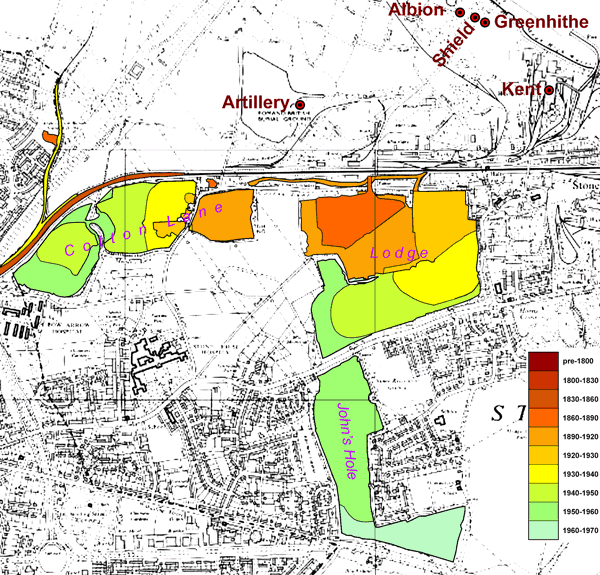
A chalk pit was already in existence at Stone Court Lodge in 1827 (note 2), The Stone Court estate began shipping chalk from their wharf in 1864. In 1873 the Stone Court Chalk Quarries Company extended the wharf to deep water, and commenced shipping ballast, while looking for cement companies that might use their chalk. In 1879 the Williams Fry and Co. Ltd Albion plant was set up to the west of the wharf, and in 1880, Wilders & Cary's Shield plant was set up to the east. In 1885 the company was re-launched as the Stone Court Land & Pier Co. Ltd. The Gillingham Portland Cement Co. Ltd set up the Greenhithe plant to the east of Shield in 1889, and in 1890 Rosher & East set up the Artillery plant inland between the quarries and the wharf. By this time, supply to the cement plants was the bulk of its trade, and chalk ceased to be shipped after 1894.
Stone Court operated two quarry complexes: the Lodge quarry south of Elizabeth Street, and a set of pits to the west on either side of Cotton Lane. The latter were opened up with a rail branch from their main rail system in 1901, and thereafter both sets of quarries were operated simultaneously. The Shield and Greenhithe plants were acquired by APCM in 1900, and the Albion and Artillery plants were acquired by BPCM in 1912. These plants were all stood down during the war period, and Stone Court then gave over most of its land to the incipient Kent Portland Cement Works Ltd, which was in its planning stages during the war. Following the failure of that company's Kent plant, ownership of the quarries became a moot point, since it all passed into the hands of Blue Circle.
The quarries were inadequate to serve the uprated Kent plant. The Cotton Lane pits were worked out by 1956. The Lodge quarry had increased amounts of gravel overburden as encountered further east, and the Atlas Stone Company - a company closely associated with (but not owned by) Blue Circle - was installed in the worked out part of the quarry to re-work the gravel for concrete products. By 1953 Lodge quarry was worked out as far as London Road, and was then desperately extended by tunnelling under the road to two narrow fields opposite, east of John's Hole. These at least gave access to the neighbouring Johnsons quarries, and when worked out in 1964, the Kent plant used only Johnsons and Swanscombe raw materials.
Iflield, Castle and Hedge Place Quarries
Base map courtesy of National Library of Scotland
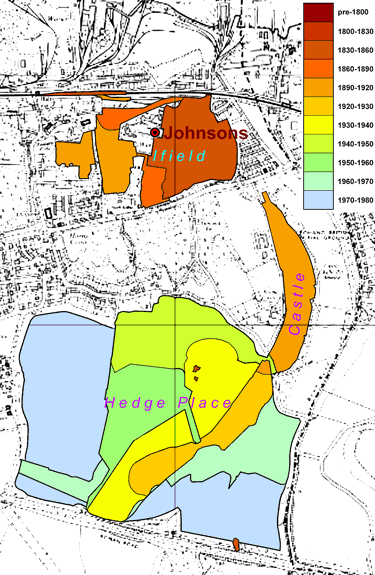
The Lambs Wharf or Ifield pit was owned by the Tildens of Ifield, and was only 270 m from the river, so tramways and a pier were installed early - 1845 or a little before - for shipping out ballast. Pre-dating the South Eastern Railway, the latter constructed the spectacular bridge still in use to cross the quarry tramways. One of Tilden's customers, though by no means the only one, was I C Johnson, who took chalk to supply his Gateshead plant. As the price of chalk delivery by sea rose, Johnson took the rational decision to buy the quarry, and to gradually re-focus his operations on Thames-side. Johnson acquired the pit in the early 1870s, and having sculpted it to suit his purposes, he built his new plant in the worked out area, beginning production in 1877. Needless to say, from then on, chalk was shipped only to his Gateshead plant. The Ifield pit was worked out by 1903, and the company were briefly in difficulty in planning future expansion. The logical move was to go into the fields to the south of London Road, but these proved to contain nothing but river terrace gravel to a great depth. After a brief (1903-1910) foray into the land south of Stone church, extension south along the Greenhithe valley was decided on.
The valley that runs northward to the Thames at Greenhithe (and once formed a tidal inlet) is a typical chalk combe - a dry dendritic valley cut by periglacial action, with a ribbon of glacial detritus - "combe deposit" - at its base. Only a narrow strip of land was available along the west side of the valley east of Stone Castle, but it was gravel-free, and gave access to vast chalk lands to the south. Johnsons accessed this by digging a tunnel under London Road, and created the Castle Pit, working their way along the valley during 1903-1920, after which the workings passed under Hedge Place Road.
Hedge Place Farm - often known in later years simply as the Western Quarry - was a large area of land - about 85 Ha - bounded on the north by Hedge Place Road, on the east by the Greenhithe combe, on the south by the Watling Street, and on the west by St James' Lane. Its chalk was relatively free of drift, and it rose to 65 m above sea level in the south. This provided Johnsons with chalk for the rest of its life (closed 1971) and also provided chalk for Kent in its final days, and for Northfleet from 1970 to 1994. The expected next step was to cross the Watling Street into the lands of the redundant Darenth Park Hospital. After this fell through the quarry was subsequently re-worked down to the permitted 10 m below sea level in some places. The pit, with lakes in areas dug below the water table, was in 1994 handed over for development as the Bluewater Shopping Centre.
Globe and Ingress Quarries
Base map courtesy of National Library of Scotland
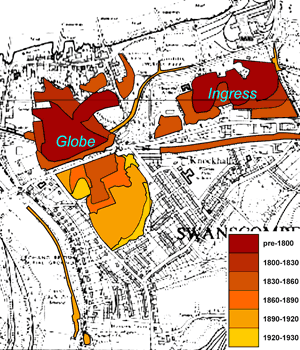
The chalk came within 100 m of the river at Old Greenhithe village and Ingress Park to the east, and the quarries there were ancient - the Ingress lands were supplying chalk in the 14th century. The Eagle or Globe quarry took a wedge of hillside immediately behind the village High Street, and had already been worked back to the London Road at the start of the 19th century. A tramway was in use to move chalk to the ballast wharf (later called New Globe Wharf) in the 1840s, and a tunnel was driven under London Road to dig chalk to the south in 1845. In 1869, J. C. Gostling set up a whiting works in this southern pit, shipping product from Globe Wharf via the tramway. Extraction ended in 1929 when the available area, surrounded by housing, was worked out. The Ingress quarry shipped only ballast chalk through its own wharf, and seems to have ceased operation before 1860. Neither of these quarries developed cement plants.
An attempt ("West Works") to start a new pit in Western Cross land was abandoned in 1901 following its acquisition by White's.
White's Quarries
Base map courtesy of National Library of Scotland
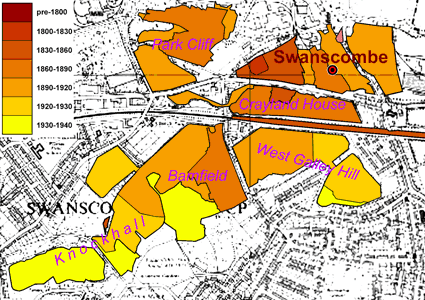
The string of quarries operated by the Swanscombe plant developed in constant competition with housing development around Swanscombe village, resulting in a straggle of small (but deep) inter-connected pits. James Frost opened the Manor Way quarry on the north side of London Road, Swanscombe in 1825. He needed chalk to make his "British Cement". There may have been a small chalk pit there previously, but the site was 1 km from the river, and was not used for ballast. Frost built a horse-drawn tramway to Bell Wharf (one of the first in the area), in order to bring in septaria and fuel and to ship out product. In 1833, Frost sold the plant to Francis & White (later John Bazley White & Bros).
The western part of Manor Way pit was worked out around 1854, and a tunnel (later several) was driven under London Road to open up the Craylands House pit, in the narrow (70-110 m) strip between London Road and the railway. This was worked between 1854 and 1888. When the central part, closest to the plant, was worked out, the plant's raw material preparation system was relocated there, and from then until the plant closed, finished slurry was pumped under the road to the plant, from several enlarged generations of raw mills. The land on the eastern side of Manor Way pit continued to be worked simultaneously with the other pits until 1916, and the cleared area was used for the eastward extension of the plant in the 1920s.
A combe ran down towards the Thames from Swanscombe Park, passing the plant's entrance. On the east side of this, the Park Cliff quarry was established in the land rising up to the boundary of the Ingress lands and quarried from 1874 to 1907. This chalk was used in part for whiting manufacture, and the quarry was operated simultaneously with other pits.
The Barnfield pit was to the west of Craylands Lane, between the combe and Milton Street and was the main development after the Craylands House pit was worked out. It was accessed through a deep tunnel beneath the railway and Craylands Lane. This pit was the first in which the overlying drift and Tertiary Beds, prominent further south, were encountered. Uncallowing of many parts took a long time. Removal of gravel began in the 1880s and was still continuing in 1935 when the "Swanscombe Skull" - a specimen of Homo Heidelbergensis was found. Because of this, the area was worked over a long period - 1885 to 1936 - while other more accessible quarries were operated simultaneously. However, the development was necessary in order to access the Swanscombe Park lands.
From the Barnfield pit, a tunnel was driven east under Craylands Lane to give access to the West Galley Hill pits. These yielded chalk without much overburden, and were worked simultaneously with the Knockhall House pits between 1908 and 1931.
The next development to the west was the three pits surrounding Knockhall House on the northeast, east and south. Here the overlying Palaeocene Thanet Sands were first encountered in quantity, and clearance of overburden became a major activity, with much of the sand back-filled into worked out sections of the earlier pits. The pits were worked during 1912-1935, and brought the Swanscombe workings up to Alkerden Lane, beyond which were the Swanscombe Park lands.
Swanscombe Park and Western Cross
Base map courtesy of National Library of Scotland
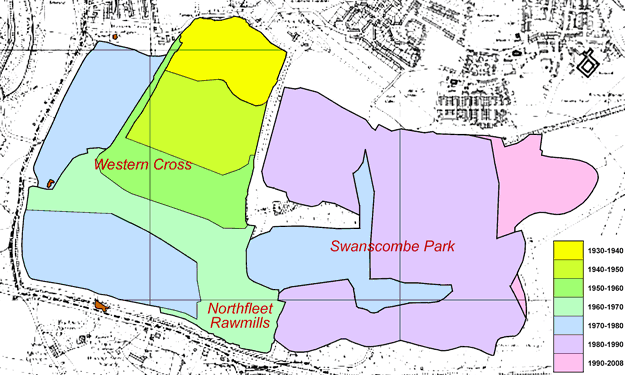
Swanscombe Park and Western Cross Farm to the west can be considered together because of their common geology. The large block of land was bounded by Alkerden Lane, Manor Road and Swanscombe village to the north, Southfleet Road to the east, Watling Street to the south and Cobham Terrace Road to the west and had an area of about 200 Ha. A tunnel under Alkerden Lane first accessed Western Cross Farm for chalk in 1935, but the area had previously been worked for clay. The hilltops reached 71 m above sea level in Swanscombe Park, and the wooded areas were indicative of the beds of Palaeocene sand and London Clay that formed them. The geology was well-established at the start of the 20th century, and a major quarrying operation - Alkerden clay plant - was established in 1909 in order to strip off the London Clay. The clay was washed to slurry at the pit and was pumped to Kent, Johnsons, Swanscombe and Bevans plants at various times as secondary raw material. This was used as a supplement to other clay sources, and the main objective of the Alkerden plant was to free up the area for chalk extraction. Clay extraction continued until 1949.
There remained the problem of disposing of the 20 m thick layer of Palaeocene sand, the outcrop of which extended well beyond that of the London Clay. When chalk extraction began in 1935, the face was worked southward through the Western Cross land, backfilling sand into the east side of the pit. By the mid-1960s, the working face was around 300 m north of the southern boundary. At this point, it was decided that the decrepit Thames-side plants would be replaced with one big new plant - this would be Northfleet. The raw material preparation department of the new plant was to be on the southern edge of the quarry, at its mid-point. From 1966, operation of the quarry was concentrated in this area in order to provide a worked-out area of around 9 Ha required to install the rawmills, blending equipment and flint plant. All four large plants - Kent, Johnsons, Swanscombe and Bevans, took chalk from here to speed up the process. It was during this flurry of activity that the progressively worse overburden to the east was recognised, but by then the Northfleet project, which depended upon the Swanscombe Park reserves, was irreversible.
After Northfleet started up in 1970, chalk was brought to the raw mills predominantly from the Hedge Place pit by 1100 t/h conveyors under Cobham Terrace Road. The extension of this into Darenth Park was rejected 1975-1978, and from then on, the exploitation of the eastern part of Swanscombe Park became inevitable. At the same time, the capacity of Northfleet was drastically reduced.

The permitted depth of extraction was down to 2.4 m above sea level in 1952. In 1969, the permit was extended to 6.7 m below sea level, and to 10 m below sea level in 1988. Large amounts of overburden were backfilled into the old Bevans quarries, while material already backfilled in the Mounts Wood pit was removed in order to reach the deeper chalk. Deep digging along the southern edge of both the Swanscombe Park and Hedge Place pits finally reached the Lewes Nodular Chalk Formation - these were the only Thames-side quarries to reach this. Later development of the Swanscombe Park area was focused on preparing it to accommodate the Ebbsfleet housing estates.
NCBC Quarries
Base map courtesy of National Library of Scotland
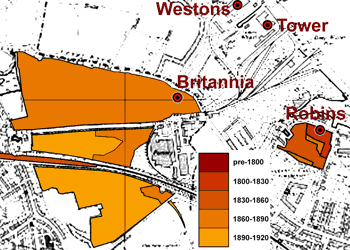
The Northfleet Coal and Ballast Company was set up informally by the management of the Robins plant in 1868, and formally as a limited company in 1873. Robins had exhausted the chalk adjacent to the plant. The company was set up to erect a deep water wharf more efficient than the existing facilities at the plant. The land on the east side of Galley Hill was secured to provide chalk for Robins in 1868. The wharf was built in 1873 and was used to bring in coal and to ship out chalk. Chalk was also offered to other prospective local manufacturers. Tower and Westons were built near the wharf in 1873 and 1874 respectively, and Britannia was constructed in a worked out part of the northern quarry in 1880.
The three customer plants were shut down by 1902, and Robins, until closure in 1910, used slurry supplied by Bevans. Bevans used the remaining chalk in the quarries from 1903 to 1921. NCBC had set up a quarry and wharf on the Essex bank in 1914, and formed the Thurrock Chalk & Whiting Company as a subsidiary in 1921. NCBC itself ceased trading in 1924, and was dissolved in 1934.
NCBC supplied Billingham until the start of war in 1914, when coastal trade became impossible, and the arrangement ceased by mutual consent. Billingham sourced local hard chalk as a replacement, installing rawmills suitable for the harder rock. After the war, Casebourne's paid NCBC a lump sum in order to be released from the ongoing contract. NCBC used this cash to write off the wharf that had been constructed to supply Casebourne's. An important decision of contract case law arose when the Inland Revenue claimed that the cash should have been declared as profit, and taxed accordingly. They lost the case, but won on appeal.
Bevans Quarries
Base map courtesy of National Library of Scotland
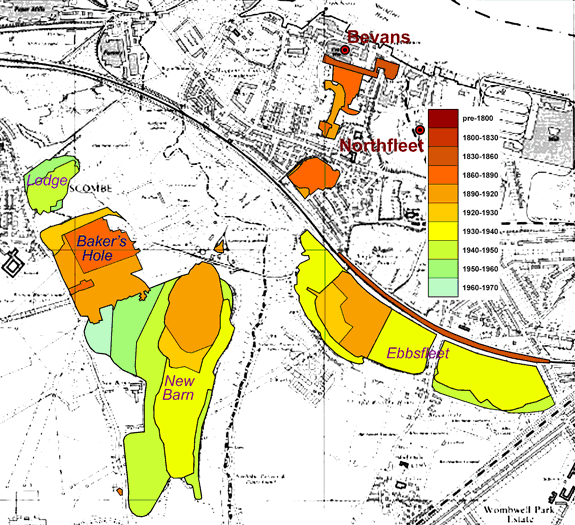
Bevans was the third cement plant to be set up in the area in 1853, and was located in a section of the shore where terrace sand and brickearth had previously been quarried. A thin strip of exposed chalk was used in its early period, but in 1878 the first tunnel was driven under Northfleet High Street and a quarry extracted chalk from the hilltop down to the Ebbsfleet. After this was worked out, around 1893, the tramway was extended across the valley to the Baker's Hole pit. This was the main quarry in use at the formation of ASTM, with a 1.5 km tram trip to the plant washmills. The running down and closure of smaller plants after 1900 freed up quarry resources which were consumed by Bevans. This included the southern parts of the NCBC quarries and the Crown and London Portland pits. From 1905, the New Barn pit, on the west side of Ebbsfleet, was opened up. Around 1910, a tunnel was driven under the railway and the western Ebbsfleet pit was started. The plant shut down for a major re-build in 1921.
Almost all the plant's equipment was replaced, including the washmills, which were relocated at the lowest part of the New Barn Pit. This was conveniently placed for gathering chalk from both sides of the Ebbsfleet valley, while clay could be obtained as slurry from the Alkerden wash plant in Swanscombe Park. From here, finished slurry was pumped to the plant. The Lodge pit, which had previously been operated for the gravel overburden, was extended into the chalk in 1926. The new washplant was fed with chalk from the Ebbsfleet, New Barn and Lodge pits. The Lodge pit was worked out in the early 1930s, and the Ebbsfleet pits were finished by 1940. From 1940 to 1964, chalk was obtained by extending and deepening the New Barn and Baker's Hole pits. From 1964, chalk was fed to the washmills via a 2 km conveyor belt from the Swanscombe Park pit. The New Barn and Baker's Hole pits were subsequently back-filled with tertiary sands and drift from Swanscombe Park, using the same conveyor system.
Crown and London Portland Quarries
Base map courtesy of National Library of Scotland
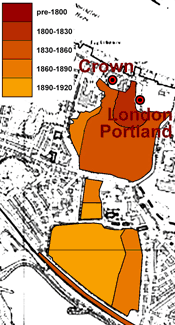
The London Portland plant began in 1868 and the Crown plant in 1876, both close to the shore in an area that had been quarried for ballast from the early 19th century. The quarry had already been worked back to the High Street before the cement plants started. The remainder of the pit was worked out by London Portland then, around 1878, a 180 m long tunnel was driven deep under The Hill, Northfleet, into the large field west of Springhead Road. This provided sufficient chalk to last the rest of the plant's life - closed 1908. Subsequently the quarry was used by Bevans, accessed through the existing tunnel, and when worked out, a further tunnel under the railway allowed access to the Ebbsfleet quarries.
The Crown plant drove a tunnel under the High Street into the smaller field west of the parish church, and this lasted until 1895, after which chalk was obtained from the London Portland quarry.
The Northfleet plant was built in the old quarry occupied by these old plants, and the two old quarry tunnels continued in use for the new plant's anti-clockwise rail loop, the London Portland tunnel forming the entrance and the Crown Tunnel forming the exit line.
Red Lion Quarries
Base map courtesy of National Library of Scotland
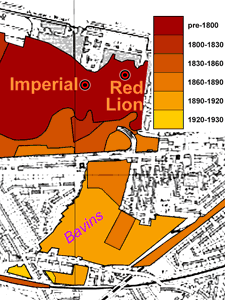
The Red Lion Wharf was a relatively modern deep-water wharf for loading ballast from a centuries-old quarry. The area had been acquired by Jeremiah Rosher in 1837, and quarrying having reached the London Road, a tunnel was driven into a field to the south in 1864. This small quarry was worked out by 1870, and a second tunnel was driven from its southern edge under Mill Road to access a larger field bounded on the south by the LC&D railway and the Dover Road.
Alfred Tolhurst bought the Rosher lands (apart from Rosherville Gardens) in 1891, and operated the quarries for ballast and for sale to cement manufacturers. He expanded activities in 1894, extending the deep water wharf to become the largest on Northfleet Reach, and buying the Bavins field, which allowed the two southern quarries to be consolidated. In 1896, he started his Red Lion cement plant close to the wharf. Tolhurst sold worked-out quarry land to the north of London Road to a variety of companies, and finally in 1898 to the Imperial cement plant, to which he undertook to supply the chalk under contract.
The quarries also supplied Bevans after Tolhurst's was taken over by BPCM in 1912. They ceased operation in 1922. The re-built Bevans plant of 1926 used the quarry trackbeds to make a standard gauge rail connection for limited non-product purposes.
Tolhurst's contract to supply chalk to Imperial led to a famous case in company law (note 3). Imperial was taken over by APCM in 1900. Tolhurst unilaterally raised the price of chalk supplied to 60% above the contract price on 13/12/1900 - the day after the transfer of Imperial to APCM. Tolhurst argued that the old contract was voided by the takeover. APCM refused to pay under these terms and chalk continued to be supplied without payment while the companies argued the point, until they finally sued each other. Tolhurst won the High Court case in June 1901; APCM appealed in August 1902 and won. A final appeal in the House of Lords in August 1903 confirmed this and it was established that a company that purchases another has the legal right to their contracts made with others.
Rosher and Clifton Quarries
Base map courtesy of National Library of Scotland
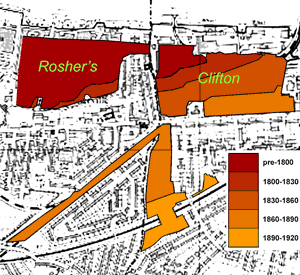
There were no more cement plants between Red Lion and Gravesend, but the area north of the Overcliffe had been quarried from early times. The western part was owned by Jeremiah Rosher and was not worked after 1825. It was developed as Rosherville. The eastern part contained lime and whiting works and continued with expansion south of Overcliffe until WWI.
Darenth Park
Base map courtesy of National Library of Scotland
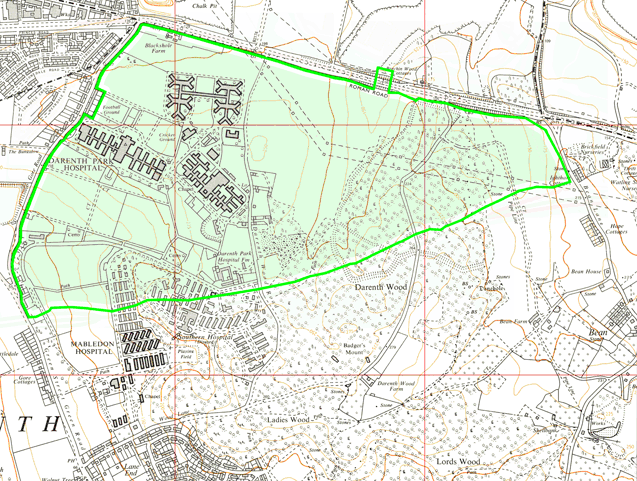
This was the quarry that never happened. The closure of the Darenth Park hospital complex was first discussed in the 1960s, and confirmed in the mid-1970s. Offering a massive area with 60 m or more of largely overburden-free chalk, Blue Circle regarded the land as a natural development of its quarrying plans. The situation became all the more urgent in the 1970s when the high overburden ratio encountered in Swanscombe Park compromised the efficiency and reserves of the new Northfleet plant. The initial reaction to the latter, in order to demonstrate low production costs at Northfleet, and to cover up the glaring errors in the project's inception, was to concentrate quarrying in the easily-worked Hedge Place pit, which could logically have been extended into Darenth Park when it was worked out. However, the 1975 planning application to initiate this was turned down by Dartford District Council, and a final appeal in 1978 failed.
This led to an immediate retrenchment in the scope of operations at Northfleet, with closure of nearly-new kilns, re-working of the existing quarries to deeper levels, and relocating large quantities of back-filled overburden that sterilised parts of both quarries. To a large extent, the retrenchment extended into the whole UK operation, spreading an air of gloom (note 4).
It can't be emphasised too much that this was a climacteric event in the history of Blue Circle. Curiously, in Peter Pugh's book, which is at least a detailed history of the later years of the company, it is not mentioned at all - at its publication in 1988, this was still not a fit subject for discussion. The fact is that, for the first 70 years of its existence, Blue Circle had treated Kent as a feudal fiefdom - what it wanted, it got. Now that was at an end. It was no longer possible to cover up the bad decision making of a management increasingly lacking operational expertise by the use of brute force. Many would see the company's subsequent tail-spin into oblivion as commencing at this point.